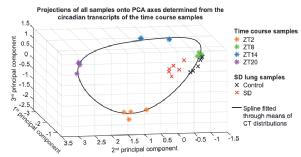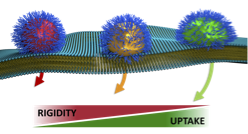Publications
A complete up-to-date list of publications of Robert can be found on Google Scholar and full-texts might be available from the Warwick Research Active Portal (WRAP).
Sleep and circadian rhythm disruption alters the lung transcriptome to predispose to viral infection - in mice
Previously a preprint hereLink opens in a new window, now out in iScience:
Great collaboration with Aarti Jagannath's lab in Oxford.
 |
Sleep and circadian rhythm disruption (SCRD), as encountered during shift work, increases the risk of respiratory viral infection including SARS-CoV-2. However, the mechanism(s) underpinning higher rates of respiratory viral infection following SCRD remain poorly characterised. To address this, we investigated the effects of acute sleep deprivation on the mouse lung transcriptome. Here we show that sleep deprivation profoundly alters the transcriptional landscape of the lung, causing the suppression of both innate and adaptive immune systems, disrupting the circadian clock, and activating genes implicated in SARS-CoV-2 replication, thereby generating a lung environment that promotes viral infection and associated disease pathogenesis. Our study provides a mechanistic explanation of how SCRD increases the risk of respiratory viral infections including SARS-CoV-2 and highlights therapeutic avenues for the prevention and treatment of COVID-19. |
NQO1 protects against clioquinol toxicity
 |
In a collaboration with Prof Güven from the University of Tasmania. CQ was widely used as oral antibiotic before removed from the market in many countries in 1970 after it was linked to subacute myelo-optic neuropathy (SMON) in Japan, leading to vision loss with many patients left wheelchair-bound. The toxic mechanism is not fullt explained yet. Given a re-emergence of CQ and related analogues as neuroprotectants, however, it is crucial to understand the underlying mechanism of CQ-induced toxicity to prevent any potential CQ-associated risks to future patients. We discovered that NQO1 protects cells against CQ toxicity in vitro and in vivo. Given the much higher prevalence of the inactivating C609T NQO1 polymorphism in the Japanese population compared to the European population, the results of this study suggest a rational for how the geographic restriction of SMON cases to Japan could be explained. Importantly, if CQ or its derivatives are to be used safely to treat neurodegenerative diseases, it seems imperative that NQO1 activity of prospective patients should be ascertained. |
Size is not everything
 |
Stiffness matters in a size dependent manner, as found out by Dr Gurnani in a very enjoyable collaboration with Seb Perrier's group, and can now be read in "small" as Probing the effect of rigidity on the cellular uptake of core-shell nanoparticles: Stiffness effects are size dependent. The use of nanoparticles as vectors for the delivery of a wide range of biomedically relevant cargo is well established. Numerous studies have investigated the impact of size, shape, charge, and surface functionality of nanoparticles on mammalian cellular uptake. Rigidity, however, has been studied to a far lesser extent, and its effects are still unclear. Here, we systematically explore the importance of this property, and its interplay with particle size, using a library of core-shell spherical PEGylated nanoparticles synthesised by RAFT emulsion polymerisation. Rigidity of these particles was controlled by altering the intrinsic glass transition temperature (Tg) of their constituting polymers. Three different polymeric core rigidities were tested: hard, medium and soft using two particle sizes, 50 and 100 nm diameters. Cellular uptake studies indicated that softer particles are taken up faster and 3-fold more into mammalian cells compared to harder nanoparticles with the larger 100 nm particles. In addition, our study indicates major differences in the cellular uptake pathway, with harder particles being internalised through clathrin- and caveolae- mediated endocytosis as well as macropinocytosis, while softer particles were taken up by mainly caveolae- and non-receptor mediated endocytosis. However, our 50 nm derivatives did not show any appreciable differences in uptake efficiency suggesting that rigidity as a parameter in the biological regime might indeed be size dependent. |
Flow Rate Independent Multiscale Liquid Biopsy for Precision Oncology
Collaborative work with Jerome Charmet and Holosensor Medical Technology Ltd.
 |
Immunoaffinity-based liquid biopsies of circulating tumour cells (CTCs) hold great promise for cancer management, but typically suffer from low throughput, relative complexity and post-processing limitations. Here we address these issues simultaneously by decoupling and independently optimising the nano-, micro- and macro-scales of a CTC enrichment device that is both simple to fabricate and operate. Our device achieved an 80% positive match in the identification of HER2+ breast cancer (n=26) compared to clinical standard FISH on solid biopsy. The results suggest that our approach, which overcomes major limitations previously associated with affinity-based liquid biopsies, could provide a versatile tool to improve cancer management. |
Renal transporter-mediated drug-biomarker interactions of the endogenous substrates creatinine and N1-methylnicotinamide: a PBPK modeling approach
Denise Türk from Thorsten Lehr's group at the University of Saarbrücken, Germany, led this work on PBPK modeling of biomarkers important for predicting drug-drug interactions mediated by kidney transporters. Obviously this is modulated by the circadian clock to some extend.

Drug-drug interactions (DDI) can lead to severe and unexpected side effects of medication because uptake, metabolism or excretion kinetics are significantly altered. For example, drug excretion in the kidney might be hampered because the relevant transporters are inhibited by a co-medication that is in the system at the same time. Thus, DDI studies are an important part of clinical investigations to determine the safety profile of novel and marketed drugs. However, testing multiple drugs in many different clinical scenarios is time-consuming and expensive. A possible improvement could be to study endogenous biomarkers that might predict DDI and facilitate better designed studies. Here, physiologically based pharmacokinetic (PBPK) modelling can help to characterise the behaviour of such biomarkers and establish the key components determining the kinetics.
Here, we developed PBPK models of the endogenous organic cation transporter (OCT) 2 and multidrug and toxin extrusion protein (MATE) 1 substrates creatinine and N1-methylnicotinamide (NMN). These performed well, i.e., aligned with the available clinical data and even took food and diurnal regulation into account. Then, the models were coupled with the previously built and evaluated models for the OCT2 and MATE1 inhibitors trimethoprim, pyrimethamine and cimetidine for DDI predictions. These models allowed us to predict previously unappreciated inhibition of NMN synthesis by trimethoprim that improved the fit to clinical data.
Thus, these whole-body PBPK models seem well suited to identify knowledge gaps and, ultimately, to facilitate investigations of renal transporter mediated DDIs during drug development.
